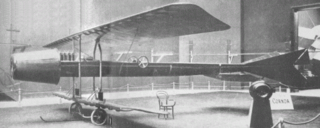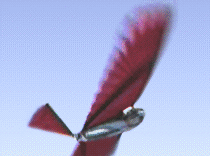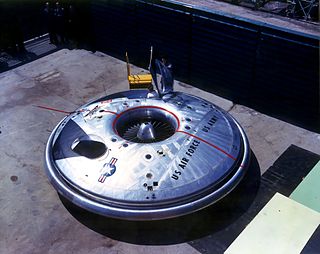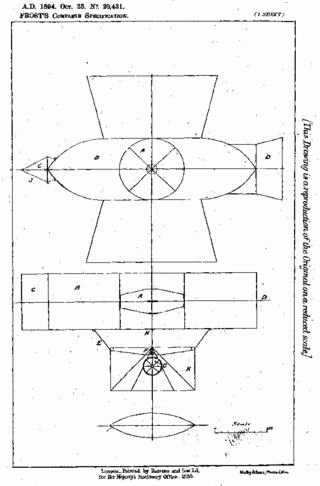
A pulsejet engine is a type of jet engine in which combustion occurs in pulses. A pulsejet engine can be made with few or no moving parts, and is capable of running statically. The best known example is the Argus As 109-014 used to propel Nazi Germany's V-1 flying bomb.

The Coandă-1910, designed by Romanian inventor Henri Coandă, was an unconventional sesquiplane aircraft powered by a ducted fan. Called the "turbo-propulseur" by Coandă, its experimental engine consisted of a conventional piston engine driving a multi-bladed centrifugal blower which exhausted into a duct. The unusual aircraft attracted attention at the Second International Aeronautical Exhibition in Paris in October 1910, being the only exhibit without a propeller, but the aircraft was not displayed afterwards, and it fell from public awareness. Coandă used a similar turbo-propulseur to drive a snow sledge, but he did not develop it further for aircraft.
Multichannel Television Sound (MTS) is the method of encoding three additional audio channels into analog 4.5 MHz audio carriers on System M and System N. It was developed by the Broadcast Television Systems Committee, an industry group, and sometimes known as BTSC as a result.

An ornithopter is an aircraft that flies by flapping its wings. Designers sought to imitate the flapping-wing flight of birds, bats, and insects. Though machines may differ in form, they are usually built on the same scale as flying animals. Larger, crewed ornithopters have also been built and some have been successful. Crewed ornithopters are generally either powered by engines or by the pilot.

John Joseph Montgomery was an American inventor, physicist, engineer, and professor at Santa Clara University in Santa Clara, California, who is best known for his invention of controlled heavier-than-air flying machines.

A radial arm saw is a cutting machine consisting of a circular saw mounted on a sliding horizontal arm. Invented by Raymond DeWalt in 1922, the radial arm saw was the primary tool used for cutting long pieces of stock to length until the introduction of the power miter saw in the 1970s.
Blowback is a system of operation for self-loading firearms that obtains energy from the motion of the cartridge case as it is pushed to the rear by expanding gas created by the ignition of the propellant charge.

Gas-operation is a system of operation used to provide energy to operate locked breech, autoloading firearms. In gas-operation, a portion of high-pressure gas from the cartridge being fired is used to power a mechanism to dispose of the spent case and insert a new cartridge into the chamber. Energy from the gas is harnessed through either a port in the barrel or a trap at the muzzle. This high-pressure gas impinges on a surface such as a piston head to provide motion for unlocking of the action, extraction of the spent case, ejection, cocking of the hammer or striker, chambering of a fresh cartridge, and locking of the action.

The Avro Canada VZ-9 Avrocar was a VTOL aircraft developed by Avro Canada as part of a secret U.S. military project carried out in the early years of the Cold War. The Avrocar intended to exploit the Coandă effect to provide lift and thrust from a single "turborotor" blowing exhaust out of the rim of the disk-shaped aircraft. In the air, it would have resembled a flying saucer.
John Kay was an English inventor best known for the development of the spinning frame in 1767, which marked an important stage in the development of textile manufacturing during the Industrial Revolution. Born in Warrington in Lancashire, England, Kay was at least the co-constructor of the first spinning frame, and was a claimant to having been its inventor. He is sometimes confused with the unrelated John Kay from Bury, Lancashire, who had invented the flying shuttle, a weaving machine, some thirty years earlier.

Charles Frances Ritchel was an American inventor of a successful dirigible design, the fun house mirror, a mechanical toy bank, and the holder of more than 150 other patented inventions.
Fabre Hydravion is the name used in English-language sources for an originally unnamed experimental floatplane designed by Henri Fabre. The aircraft is notable as the first to take off from water under its own power.

Pterodactyl was the name given to a series of experimental tailless aircraft designs developed by G. T. R. Hill in the 1920s and early 1930s. Named after the genus Pterodactylus, a well-known type of pterosaur commonly known as the pterodactyl, all but the first were produced by Westland Aircraft Ltd after Hill joined them.
Preston Albert Watson was a Scottish aviation pioneer, who conceived his own original method of controlling an aeroplane in flight. This was his rocking wing method of lateral control, which consisted of a secondary smaller wing mounted above the main wing on an A-frame that could pivot about its longitudinal axis. Watson's method of lateral control was applied by him in three different aeroplanes; the first was built in late 1909, the second in July 1910 and his third in 1913.

William Frost was a Welsh designer of an early flying machine, the Frost Airship Glider.
Rowell v. Lindsay, 113 U.S. 97 (1885), was a bill brought by the appellants, John S. Rowell and Ira Rowell, the plaintiffs in the circuit court. The bill was in equity against Edmund J. Lindsay and William Lindsay, the appellees, to restrain the infringement of reissued letters patent No. 2,909, dated March 31, 1868, granted to the plaintiffs for 'a new and improved cultivator.

Francis Herbert Wenham was a British marine engineer who studied the problem of human flight and wrote a perceptive and influential academic paper, which he presented to the first meeting of the Royal Aeronautical Society in London in 1866. He was the son of a British army surgeon.
A composite aircraft is made up of multiple component craft. It takes off and flies initially as a single aircraft, with the components able to separate in flight and continue as independent aircraft. Typically the larger aircraft acts as a carrier aircraft or mother ship, with the smaller sometimes called a parasite or jockey craft.
The Short S.6 Sturgeon was a prototype single-engined biplane naval reconnaissance aircraft, built to an Air Ministry specification but mostly intended as a demonstrator of the corrosion resistance of duralumin aircraft structures. Two were made.
Recoil operation is an operating mechanism used to implement locked-breech autoloading firearms. Recoil operated firearms use the energy of recoil to cycle the action, as opposed to gas operation or blowback operation using the pressure of the propellant gas.











